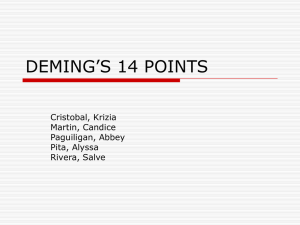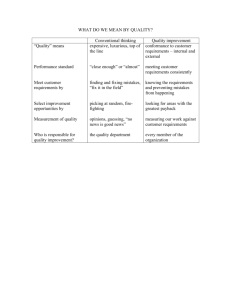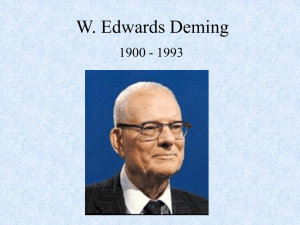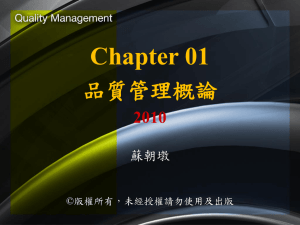quantitative values for organizational culture constructs
advertisement
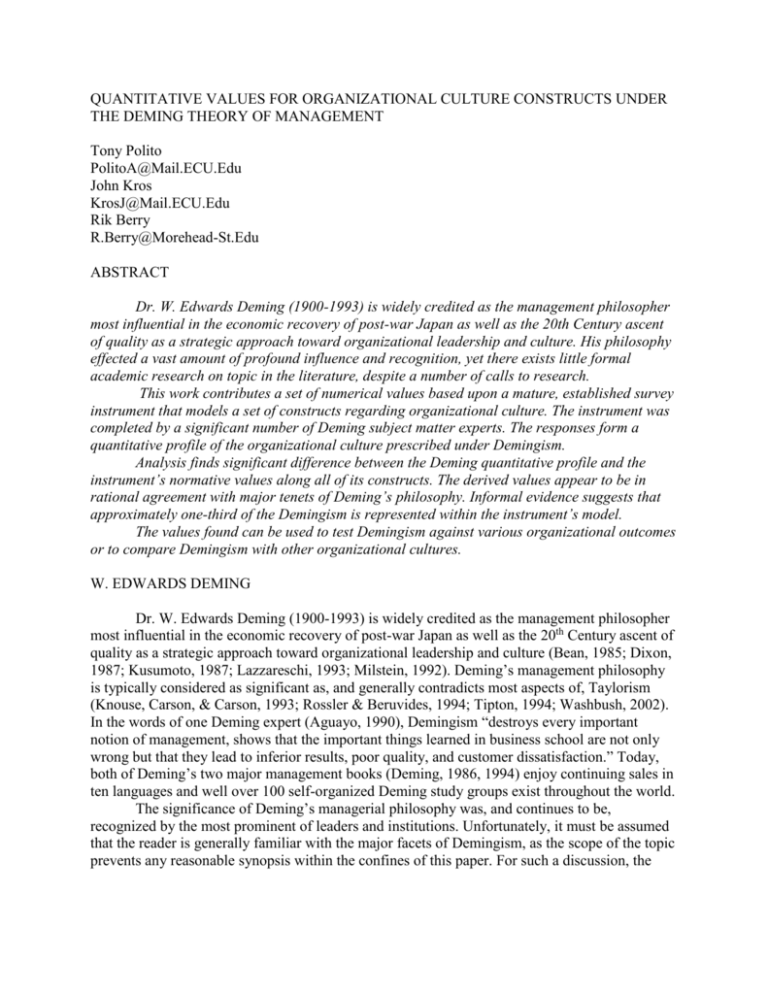
QUANTITATIVE VALUES FOR ORGANIZATIONAL CULTURE CONSTRUCTS UNDER THE DEMING THEORY OF MANAGEMENT Tony Polito PolitoA@Mail.ECU.Edu John Kros KrosJ@Mail.ECU.Edu Rik Berry R.Berry@Morehead-St.Edu ABSTRACT Dr. W. Edwards Deming (1900-1993) is widely credited as the management philosopher most influential in the economic recovery of post-war Japan as well as the 20th Century ascent of quality as a strategic approach toward organizational leadership and culture. His philosophy effected a vast amount of profound influence and recognition, yet there exists little formal academic research on topic in the literature, despite a number of calls to research. This work contributes a set of numerical values based upon a mature, established survey instrument that models a set of constructs regarding organizational culture. The instrument was completed by a significant number of Deming subject matter experts. The responses form a quantitative profile of the organizational culture prescribed under Demingism. Analysis finds significant difference between the Deming quantitative profile and the instrument’s normative values along all of its constructs. The derived values appear to be in rational agreement with major tenets of Deming’s philosophy. Informal evidence suggests that approximately one-third of the Demingism is represented within the instrument’s model. The values found can be used to test Demingism against various organizational outcomes or to compare Demingism with other organizational cultures. W. EDWARDS DEMING Dr. W. Edwards Deming (1900-1993) is widely credited as the management philosopher most influential in the economic recovery of post-war Japan as well as the 20th Century ascent of quality as a strategic approach toward organizational leadership and culture (Bean, 1985; Dixon, 1987; Kusumoto, 1987; Lazzareschi, 1993; Milstein, 1992). Deming’s management philosophy is typically considered as significant as, and generally contradicts most aspects of, Taylorism (Knouse, Carson, & Carson, 1993; Rossler & Beruvides, 1994; Tipton, 1994; Washbush, 2002). In the words of one Deming expert (Aguayo, 1990), Demingism “destroys every important notion of management, shows that the important things learned in business school are not only wrong but that they lead to inferior results, poor quality, and customer dissatisfaction.” Today, both of Deming’s two major management books (Deming, 1986, 1994) enjoy continuing sales in ten languages and well over 100 self-organized Deming study groups exist throughout the world. The significance of Deming’s managerial philosophy was, and continues to be, recognized by the most prominent of leaders and institutions. Unfortunately, it must be assumed that the reader is generally familiar with the major facets of Demingism, as the scope of the topic prevents any reasonable synopsis within the confines of this paper. For such a discussion, the reader is directed to either Deming’s two major books (Deming, 1986, 1994) or popularizations by Aguayo (Aguayo, 1990), Neave (Neave, 1990) and/or Walton (Walton, 1986). REVIEW OF THE LITERATURE AND CALLS TO RESEARCH Clearly, Deming’s management philosophy, having effected such a vast amount of profound influence and recognition, is deserving of academic study under scientific method. Yet there exists little formal academic research on topic in the literature. The recent review of the literature for this study investigated the entries within databases providing full coverage for well over 10,000 journals and trade magazines; that search located approximately 150 articles, forty books, 100 article abstracts, fifteen dissertation abstracts, 100 newspaper articles and 100 newspaper article abstracts regarding Demingism. Among them, only twenty works were identified that could be fairly described as rigorous, quantitative analytical attempts to build knowledge via generally accepted scientific methods. The balance of the literature is best described as trade press cases informally anecdoting successful improvement through employment of Demingism, articles seeking to clarify and or exemplify some portion of Demingism or articles seeking to restate basic Deming principles toward a niche or neophyte audience, functional area or industry. This lack of formal investigation exists despite a number of calls to research. Accordingly, this study addresses that recognized deficiency with more formal research of Demingism, a management philosophy frequently recognized, through anecdotal case study, inferential evidence and prestigious honors, as being highly effective. RESEARCH QUESTION AND METHOD Given the lack of existing research, special consideration was given to the aim of this study, in order to ensure a useful foundation for future work. Ideally, future research would ultimately result in the ability to posit the relationship between Demingism and successful organizational outcomes such as profitability, efficiency and/or worker satisfaction. However, this is not, at this point in time, truly possible since there are no established Demingism operational constructs, or associated numerical values, that could be employed in such comparisons. In fact, there is no valid method for either assuring or falsifying Demingism in practice. A set of such constructs and associated numerical values are, therefore, prerequisite to further formal study of the Deming philosophy. Accordingly, this work contributes a subset of such numerical values, specifically a set of numerical values based upon a mature, established set of constructs regarding organizational culture. Hence the primary research question addressed by this study is “What specific numerical values would result from measuring the organizational culture prescribed by Demingism?” The values that resulted from this study can be cited and employed by future researchers in the testing of the relationship between the organizational culture prescribed under Demingism and various organizational outcomes. The values can also be used to directly compare the organizational culture prescribed by Demingism with other organizational cultures when measured in a similar manner. In this study, the instrument was distributed to, and completed by, a number of individuals that can be regarded as Demingism subject matter experts. The responses of these participants resulted mean values for each of the ten constructs that form a quantitative “profile” of the organizational culture prescribed under Demingism. DATA ANALYSIS AND RESULTS A satisfactory survey response rate was obtained. Twenty-three usable instrument responses were returned, representing 48.9% of those individuals surveyed. Information was obtained from approximately nearly half of the individuals who did not return any portion of the survey regarding their lack of response; the information suggested low likelihood of non-response bias. The responses returned from the Deming subject matter experts were aggregated to determine the numerical values for each of the ten constructs, then compared to the corresponding normative sample mean. Significance was also found for all ten constructs within the instrument. Table 1 summarizes the results of the ten aforementioned tests of significance: Table 1 Results of Significance Tests, Demingism versus Normative Values Construct Demingism Mean Normative Mean Involvement Coworker Cohesion Supervisor Support Autonomy Task Orientation Work Pressure Clarity Managerial Control Innovation Physical Comfort 8.174 7.957 7.783 7.174 7.739 3.652 7.565 3.217 7.435 7.130 5.710 5.520 5.180 5.470 5.860 5.310 4.910 5.260 4.090 4.240 Higher/Lower Degree Under Demingism Higher Higher Higher Higher Higher Lower Higher Lower Higher Higher In addition to completion of the instrument, the Deming subject matter experts were asked to respond to the following discussion question: “What percentage of the Deming philosophy do you believe is addressed by the preceding survey instrument?” The intent of the question was to seek support for the initial assumption that the instrument generally corresponds to a number of central organizational themes that comprise the Deming philosophy. Twenty-two usable supplementary discussion responses were returned by the Deming subject matter experts, representing 46.8% of those surveyed. Table 2 summarizes the basic descriptive statistics derived from the twenty-two responses, while Table 3 summarizes the frequency of the responses using 10% bins. Table 2 Descriptive Statistics, Percentage of Demingism Content within Instrument Mean Median 36.2% 30.0% Std. Dev. Variance 24.2% 5.9% Minimum 1.0% Maximum 88.0% Range 87.0% Mode 50.0% (f=4) Table 3 Frequency Table, Percentage of Demingism Content within Instrument 10% 20% 30% 40% 50% 4 5 3 1 4 60% 70% 80% 90% 100% 1 1 2 1 0 The dispersions observed in the standard deviation, range, as well as across the frequency bins, evidence that there was no clear consensus among the Deming subject matter experts regarding the actual percentage of content. However, the mean, median and mode do all provide strong informal evidence that the instrument content does, beyond a trivial extent, correspond to a number of central organizational themes that comprise the Deming philosophy. Based upon the dispersion across the frequency bins, that correspondence can reasonably be said to be less than, or equal to, 50% of the total Deming philosophy. Some insight into the nature of the unaddressed percentage of Demingism can be drawn from the discussions included with the percentage responses. Several of the discussions noted that the instrument did not address Demingism’s systematic perspective, emphasis on the importance of statistical variation, supplier/customer philosophies or epistemological theory. These discussions suggest that the unaddressed percentage of Demingism does not pertain to facets of organizational culture climate or environment, further strengthening the argument that the instrument is highly explanatory with regard to the organizational culture prescribed by Demingism. CONCLUSION Most of the Demingism values derived from the appear to be in general agreement with major tenets of Deming’s philosophy. The full paper contains a more detail discussion of this concordance, as well as discussion that contrasts with Taylorism. The results of this study open a number of areas to future research. The values found can be used to identify organizations possessing a Demingistic organizational culture, and so compare that culture with various organizational outcomes such as profitability, efficiency and/or worker satisfaction. The values can also be used to falsify a claim that a particular organization is Demingistic in nature, to lend support to such a claim or to identify gaps between the organizational culture prescribed by Demingism and the actual organizational culture found. Further, the values can be used to compare organizations deemed successful by any particular criteria, in order to determine if successful companies are (or are not) Demingistic in nature. They may also be used to compare Demingistic organizational culture with the organizational culture prescribed by other managerial philosophies. The results also identify areas requiring further research. The extremely significant value determined for involvement calls for further examination and explanation. Given Deming’s focus upon the pivotal role of leadership, higher significance could have been expected for the supervisor support construct. Other instruments should be located and employed to increment explanatory power with regard to Demingism’s systematic perspective, emphasis on the importance of statistical variation, supplier/customer philosophies and epistemological theory. In conclusion, this study contributes a degree of quantitative texture to Deming’s ethereal philosophy, thereby facilitating numerous opportunities for further research employing traditional scientific methods. In addition, this study suggests a methodology for doing so with other managerial philosophies that influence organizational culture as well. Full paper is 4800+ words and contains 36 references. References available upon request.

